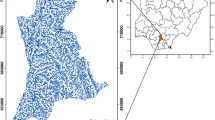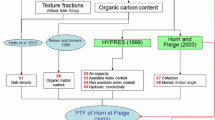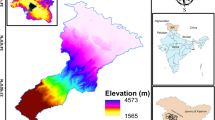Abstract
Rainfall-induced progressive soil erosion of compacted surface layer (SL) impedes the functioning of cover system (CS) of landfills with high expected design life (≈ 100 years). The existing soil erosion models are not tested extensively for compacted soil with cracks and vegetation. This study evaluated the efficacy of three popular soil erosion models for estimating the soil loss of compacted SL of CS, which is useful for annual maintenance. The interactive effect of rainfall, vegetation and desiccation cracks on erosion of compacted surface layer was investigated under the influence of both natural and simulated rainfall events for one year. Among all, the Morgan, Morgan and Finney (MMF) model was found to be effective in predicting soil erosion of compacted SL. However, the MMF model overestimated soil erosion when the vegetation cover exceeded 60%. The soil loss estimated from Revised Universal Soil Loss Equation (RUSLE) and Water Erosion Prediction Project (WEPP) models was poor for high rainfall intensity (100 mm/h). The RUSLE and WEPP model overestimated the soil erosion for low vegetation cover (≤ 3%) and underestimated for vegetation area > 3%. The mechanism of root reinforcement, strength due to root water uptake-induced soil suction and its effect on soil loss mitigation could not be adequately captured by the existing models for compacted SL. Further studies are needed to improve the existing erosion models for incorporating the effects of desiccation and vegetation on soil loss from the compacted SL.










Similar content being viewed by others
Data availability statement
Data are available on request.
References
Abu Hammad A, Lundekvam H, Børresen T (2005) Adaptation of RUSLE in the eastern part of the Mediterranean region. Environ Manage 34:829–841. https://doi.org/10.1007/s00267-003-0296-7
Adekalu KO, Okunade DA, Osunbitan JA (2006) Compaction and mulching effects on soil loss and runoff from two southwestern Nigeria agricultural soils. Geoderma 137(1–2):226–230
Aksoy H, Unal NE, Cokgor S, Gedikli A, Yoon J, Koca K, Inci SB, Eris E (2012) A rainfall simulator for laboratory-scale assessment of rainfall-runoff-sediment transport processes over a two-dimensional flume. CATENA 98:63–72. https://doi.org/10.1016/j.catena.2012.06.009
Allen RG, Pereira LS, Raes D, Smith M (1998) Crop Evapotranspiration-Guidelines for computing crop water requirements-FAO Irrigation and drainage paper 56. FAO Rome 300(9):D05109
Beasley DB, Huggins LF, Monke A (1980) ANSWERS: a model for watershed planning. Trans ASAE 23(4):938–0944
Boldrin D, Leung AK, Bengough AG (2017) Correlating hydrologic reinforcement of vegetated soil with plant traits during establishment of woody perennials. Plant Soil 416(1–2):437–451
Bordoloi S, Gadi VK, Hussain R, Garg A, Sreedeep S, Poulsen T (2018a) ’Influence of fibre from waste weed Eichhornia crassipes on water retention and cracking characteristics of vegetated soils’. Geotech Lett 8:130–137
Bordoloi S, Hussain R, Gadi VK, Bora H, Sahoo R, Karangat R, Garg A (2018b) ’Monitoring soil cracking and plant parameters for a mixed grass species’. Géotechnique Letters 8:49–55
Brown LC, Foster GR (1987) Storm erosivity using idealized intensity distributions. Trans ASAE 30:379–386
Cai CF, Ding SW, Shi ZH (2000) Study of applying USLE and geographical information system IDRISI to predict soil erosion in small watershed. J Soil Water Conserv 14(2):19–24
Chaney K, Swift RS (1984) The influence of organic matter on aggregate stability in some British soils. J Soil Sci 35:223–230
Choi K, Huwe B, Reineking B (2017) Commentary on modified MMF (Morgan-Morgan Finney) model for evaluating effects of crops and vegetation cover on soilerosion by Morgan and Duzant (2008). arXiv:1612.08899
Christiansen JE (1941) The uniformity of application of water by sprinkler system. Agric Eng 22:89–92
Cruse RM, Larson WE (1977) Effect of soil shear strength on soil detachment due to raindrop impact. Soil Sci Soc Am 1.41(4):777–781
Dawkins TCK, Hebblethwaite PD, McGowan M (1984) Soil compaction and the growth of vining peas. Ann Appl Biol 105(2):329–343
De Roo APJ, Wesseling CG, Ritsema CJ (1996) LISEM: a single-event physically based hydrological and soil erosion model for drainage basins. I: theory, input and output. Hydrol Process 10(8):1107–1117
Devia GK, Ganasri BP, DwarakishGS (2015) A review on hydrological models. Aquat Procedia 4:1001–1007. https://doi.org/10.1016/j.aqpro.2015.02.126
Dun S, Wu JQ, Elliot WJ, Frankenberger JR, Flanagan DC, McCool DK (2013) Applying online WEPP to assess forest watershed hydrology. Trans ASABE 56(2):581–590
Dymond JR (2010) Soil erosion in New Zealand is a net sink of CO2, Earth surf. Proc Land 35:1763–1772. https://doi.org/10.1002/esp.2014
Eusebius NP, Papalia L, Suphioglu C, McLellan SC, Varney M, Rolland JM, O’Hehir RE (2002) Oligoclonal analysis of the atopic T cell response to the group 1 allergen of Cynodon dactylon (bermuda grass) pollen: pre-and post-allergen-specific immunotherapy. Int Arch Allergy Imm 127(3):234–244. https://doi.org/10.1159/000053868
Flanagan DC, Nearing MA (1995) USDA-water erosion prediction project: hillslope profile and watershed model documentation. Nserl Rep 10:1–123. NSERL Report No. 10. USDA ARS National Soil Erosion Research Laboratory: West Lafayette, IN
Fernández C, Vega JA, Vieira DCS (2010) Assessing soil erosion after fire and rehabilitation treatments in NW Spain: performance of RUSLE and revised Morgan–Morgan–Finney models. Land Degrad Dev 21(1):58–67
Foster GR, Meyer LD (1972) Transport of soil particles by shallow flow. Transactions of the ASAE 15.1:99-0102.1
Gadi VK, Bordoloi S, Garg A, Sahoo L, Berretta C, Sreedeep S (2017) Effect of shoot parameters on cracking in vegetated soil. Environ Geotech 1–31. https://doi.org/10.1680/jenge.17.00013
Garg A, Leung AK, Ng CWW (2015) Comparisons of soil suction induced by evapotranspiration and transpiration of S. heptaphylla. Can Geotech J 52(12):2149–2155
Garg A, Bordoloi S, Ni J, Cai W, Maddibiona PG, Mei G, Lin P (2019) “ Influence of biochar addition on gas permeability in unsaturated soil. Géotechnique Lett 9:1–20
Hikhailova EA, Bryant RB, Schwager SJ, Smith SD (1996) Predicting rainfall erosivity in Honduras
Hong HS, Huang JL, Cao WZ (2008) Agricultural non-point source pollution mechanism and control research in Jiulong River watershed. Science Press, Beijing
Jotisankasa A, Sirirattanachat T (2017) Effects of grass roots on soil-water retention curve and permeability function. Can Geotech J 54(11):1612–1622
Kinnell PIA (2010) Event soil loss, runoff and the Universal Soil Loss Equation family of models: a review. J Hydrol 385(384):397
Klik A, Haas K, Dvorackova A, Fuller IC (2015) Spatial and temporal distribution of rainfall erosivity in New Zealand. Soil Res 53:815–825
Knisel WG (1980) CREAMS: a field scale model for chemicals, runoff, and erosion from agricultural management systems. Department of Agriculture, Science and Education Administration
Liang T, Bengough AG, Knappett JA, MuirWood D, Loades KW, Hallett PD, Boldrin D, Leung AK, Meijer GJ (2017). Scaling of the reinforcement of soil slopes by living plants in a geotechnical centrifuge. Ecol Eng
Liu BY, Xie Y, Zhang KL (2001) Prediction model of soil loss. Beijing: China. Science and Technology Press
Loades KW, Bengough AG, Bransby MF, Hallett PD (2015) Effect of root age on the biomechanics of seminal and nodal roots of barley (Hordeum vulgare L.) in contrasting soil environments. Plant Soil 395 (1–2): 253–261
López-Vicente M, Navas A, Machín J (2008) Identifying erosive periods by using RUSLE factors in mountain fields of the Central Spanish Pyrenees. Hydrol Earth Syst Sci 12:523–535. https://doi.org/10.5194/hess-12-523-2008
Martínez-Murillo JF, Remond R, Ruiz-Sinoga JD (2020) Validation of RUSLE K factor using aggregate stability in contrasted mediterranean eco-geomorphological landscapes (southern Spain). Environ Res 183:109160
Mondal A, Khare D, Kundu S (2018) A comparative study of soil erosion modelling by MMF, USLE and RUSLE. Geocarto Int 33(1):89–103
Monteith JL (1965) Evaporation and environment. In Symp Soc Exp Biol 19(205–23):4
Morgan RPC (2001) A simple approach to soil loss prediction: a revised Morgan–Morgan–Finney model. CATENA 44(4):305–322
Morgan RPC, Morgan DDV, Finney HJ (1984) A predictive model for the assessment of soil erosion risk. J Agric Eng Res 30:245–253
Morgan RPC, Quinton JN, Smith RE, Govers G, Poesen JWA, Auerswald K, Chisci G, Torri D, Styczen ME (1998) The European soil erosion model EUROSEM: a dynamic approach for predicting sediment transport from fields and small catchments. Earth Surf Process Landforms 23:527–544
Morgan RPC (2005) Soil erosion and conservation. National Soil Resources Institute, Cranfield University. https://doi.org/10.1002/9781118351475.ch22
Musgrave GW (1947) The quantitative evaluation of factors in water erosion: a first approximation. J Soil Water Conserv 2(3):133–138
Mutchler CK, Young RA (1975) Soil detachment by raindrops, present and prospective technology for predicting sediment yield and sources. USDA Annual Report, pp 5–40
Ng CWW, Leung AK, Woon KX (2013a) Effects of soil density on grass-induced suction distributions in compacted soil subjected to rainfall. Canadian Geotech J 51(3):311–321
Ng CWW, Leung AK, Garg A, Woon KX, Chu LM, Hau BCH (2013) Soil suction induced by grass and tree in an atmospheric-controlled plant room. In: Proceedings of the 18th international conference on soil mechanics and geotechnical engineering, Paris, pp 1167–1170
Ng CWW, Menzies BK (2007) Unsaturated soil mechanics and engineering. Taylor & Francis
Panagos P, Borrelli P, Poesen J, Ballabio C, Lugato E, Meusburger K, Alewell C (2015) The new assessment of soil loss by water erosion in Europe. Environ Sci Policy 54:438–447. https://doi.org/10.1016/j.envsci.2015.08.012
Parker DB, Michel TG, Smith JL (1995) Compaction and water velocity effects on soil erosion in shallow flow. J Irrig Drain Eng 121(2):170–178
Post DA, Hartcher MG (2005) Evaluating uncertainty in modelled sediment delivery in data-sparse environments: application to the Mae Chaem Catchment.” Thailand. In: Proceedings of symposium S7 held during the Seventh IAHS Scientific Assembly, 80–89, Foz do Iguaçu
Poulsen TG, Cai W, Garg A (2019) Water evaporation from cracked soil under moist conditions as related to crack properties and near‐surface wind speed. Eur J Soil Sci
Raghavan GSV, Ohu JO (1985) Prediction of static equivalent pressure of proctor compaction blows. Trans ASAE 28(5):1398–1400
Renard KG, Foster GR, Weesies GA, McCool DK, Yoder DC (1997) Predicting soil erosion by water: a guide to conservation planning with the Revised Universal Soil Loss Equation (RUSLE). United States Department of Agriculture, Washington, DC
Sahli Y, Mokhtari E, Merzouk B, Laignel B, Vial C, Madani K (2019) Mapping surface water erosion potential in the Soummam watershed in Northeast Algeria with RUSLE model. J Mt Sci 16(7):1606–1615
Schmidt S, Alewell C, Meusburger K (2019) Monthly RUSLE soil erosion risk of Swiss grasslands. J Maps 15(2):247–256
Shaikh J, Yamsani SK, Bora MJ, Sekharan S, Rakesh RR, Mungale A, Bordoloi S (2019) Impact assessment of vegetation growth on soil erosion of a landfill cover surface. Acta Horticulturae Et Regiotecturae 22(2):75–79
Singh G, Rambabu, Chander S (1981) Soil loss prediction research in India. Bull. No. T-12/D-9. CSWCR AND T1, Dehradun
Singh RK, Panda RK, Satapathy KK, Ngachan SV (2012) Runoff and sediment yield modelling for a treated hilly watershed in Eastern Himalaya using the water erosion prediction project model. Water Resour Manage 26(3):643–665
Sinha D, Joshi VU (2012) Application of universal soil loss equation (USLE) to recently reclaimed badlands along the Adula and Mahalungi Rivers, Pravara Basin, Maharashtra. J Geol Soc India 80(3):341–350
Song L, Li JH, Zhou T, Fredlund DG (2017) Experimental study on unsaturated hydraulic properties of vegetated soil. Ecol Eng 103:207–216
Sutherland RA, Wan Y, Ziegler AD, Lee CT, El-Swaify SA (1996) Splash and wash dynamics: an experimental investigation using an Oxisol. Geoderma 69(1):85–103
Thorne CR, Zevenbergen LW, Grissinger EH, Murphey JB (1985) Calculator programe and nomograph for on-site predictions of ephemeral gully erosion. United States Department of Agriculture Soil Conservation Service, United States
Torri D, Poesen J, Borselli L, Knapen A (2006) Channel width–flow discharge relationships for rills and gullies. Geomorphology 76(3–4):273–279
USEPA (1989) Risk assessment: guidance for superfund. In: Human health evaluation manual (Part A), interim final, vol 1. Office of Emergency and Remedial Response, U.S. Environmental Protection Agency, Washington DC
Wautersa E, Bieldersb C, Poesenc J (2010) Adoption of soil conservation practices in Belgium: an examination of the theory of planned behavior in the agri-environmental domain. Land Use Policy 27:86–94
Williams JR, Berndt HD (1977) Sediment yield prediction based on watershed hydrology. Trans ASAE 20(6):1100–1104
Williams RJ, Renard KG (1983) EPIC – a new method for assessing erosions effect on soil productivity. J Soil Water Conserv 38:381–383
Wischmeier WH, Smith DD (1965) Rainfall-erosion losses from cropland east of the rocky mountains: guide for election of practices for soil and water conservation (Agricultur.). U.S. Governmental Printing Office, Washington
Wischmeier WH, Smith DD (1978) Predicting rainfall erosion losses: a guide to conservation planning. Department of Agriculture, Science and Education Administration
Xue Q, Chen YJ, Liu L (2016) Erosion characteristics of ecological sludge evapotranspiration cover slopes for landfill closure. Environmental Earth Sciences 75(5):419
Yamsani SK, Dey A, Sekharan S, Rakesh RR (2019) Vulnerable interface diagram for translational stability analysis of multilayered cover system. Int J Geomech 19(12):04019130
Yang D, Kanae S, Oki T, Koike T, Musiake K (2003) Global potential soil erosion with reference to land use and climate changes. Hydrol Process 17(14):2913–2928. https://doi.org/10.1002/hyp.1441
Zhao L, Yuan GL, Zhang Y, He B, Liu ZH, Wang ZY, Li J (2007) The amount of soil erosion in Baoxiang Watershed of Dianchi Lake based on GIS and USLE. Bull Soil Water Conserv 27(3):42–46
Zheng ZC, He SQ, Wu FQ (2014) Changes of soil surface roughness under water erosion process. Hydrol Process 28(12):3919–3929. https://doi.org/10.1002/hyp.9939
Acknowledgements
The authors would like to acknowledge the project (Grant no. 2013/36/06-BRNS) supported by Board of Research in Nuclear Sciences (BRNS), Department of Atomic Energy (DAE), India. The fourth author is also grateful to the National Natural Science Foundation of China (NSFC) for the project (Grant no. 41907252).
Author information
Authors and Affiliations
Corresponding author
Ethics declarations
Conflict of interest
The authors declare that they have no conflict of interest.
Additional information
Communicated by Dr. Michael Nones (CO-EDITOR-IN-CHIEF).
The original online version of this article was revised: wrong category name.
Rights and permissions
About this article
Cite this article
Bora, M.J., Bordoloi, S., Pekkat, S. et al. Assessment of soil erosion models for predicting soil loss in cracked vegetated compacted surface layer. Acta Geophys. 70, 333–347 (2022). https://doi.org/10.1007/s11600-021-00698-z
Received:
Accepted:
Published:
Issue Date:
DOI: https://doi.org/10.1007/s11600-021-00698-z




